What is Mendel’s Law of Independent Assortment?
- Mendel’s Law of Independent Assortment is a fundamental principle of genetics that highlights the way traits are passed from one generation to the next. This law states that when two or more pairs of contrasting traits are inherited, the inheritance of one trait does not influence the inheritance of another. Essentially, each trait is independently passed to offspring, regardless of the other traits being inherited.
- This principle emerged from Mendel’s experiments involving a dihybrid cross, where he observed pea plants exhibiting two different traits at the same time. Through these experiments, Mendel found that the combination of traits in the offspring often differed from those seen in the parents. This indicated that the alleles for different traits segregated independently into the gametes during reproduction.
- The law describes how genes for different traits, which are located on separate chromosomes, are randomly distributed to the offspring. This randomness helps explain the vast variety of genetic combinations that can result from the same set of parental genes. Consequently, this independent assortment contributes to genetic diversity in offspring.
- The importance of Mendel’s Law of Independent Assortment lies in its ability to explain why specific traits appear in offspring without being affected by other traits, providing a basis for understanding complex inheritance patterns.
Definition of Mendel’s Law of Independent Assortment
Mendel’s Law of Independent Assortment states that genes for different traits are distributed to gametes independently of one another, meaning the inheritance of one trait does not affect the inheritance of another.
Characteristics of Mendel’s Law of Independent Assortment
- Basis in Meiosis
Mendel’s Law of Independent Assortment is rooted in the process of meiosis, the type of cell division that generates haploid gametes from diploid cells during sexual reproduction. During meiosis, chromosomes separate, ensuring that each gamete carries only one set of chromosomes, and this segregation occurs independently for each chromosome pair. - Independent Chromosome Assortment
The chromosomes that originate from each parent are assorted into the gametes randomly. This randomness ensures that traits encoded on different chromosomes are inherited independently, leading to a variety of genetic combinations in offspring. - Recombination and Genetic Diversity
Besides independent assortment, recombination during meiosis further shuffles genetic material. Recombination refers to the exchange of chromosome segments between homologous chromosomes, creating new allele combinations that increase the genetic diversity of offspring. - Random Segregation of Genes
Independent assortment applies to genes located on different chromosomes, meaning that one trait’s inheritance does not influence another. For example, when a pea plant with yellow round seeds (YYRR) is crossed with one having green wrinkled seeds (yyrr), the alleles segregate into gametes independently, leading to a variety of genotypic combinations like YyRR, YyRr, and YYrr. - Varied Offspring Phenotypes
This principle is crucial in explaining why offspring can exhibit combinations of traits not necessarily seen in the parents. The independent segregation of alleles allows for phenotypic diversity, such as the ability of the R allele to appear with other combinations like YY or Yy, independent of its association with Y in the parent generation. - Equal Probability of Allele Expression
Mendel’s law explains that each allele has an equal chance of being expressed in the offspring, as genes are passed independently. This principle is a foundational concept for understanding how genetic variation arises naturally in populations.
Examples of Mendel’s Law of Independent Assortment
- Mendel’s Pea Plant Experiments
Mendel’s classic experiments with pea plants provide a clear illustration of the Law of Independent Assortment. In a dihybrid cross, Mendel used a homozygous pea plant with yellow round seeds (YYRR) and crossed it with a homozygous pea plant with green wrinkled seeds (yyrr).- Gamete Formation: During meiosis, the chromosomes segregate so that gametes carry only one allele for each trait. The resulting gametes are YR and yr.
- F1 Generation: The cross of these gametes produces F1 hybrids with the genotype YyRr, displaying yellow round seeds due to the dominance of Y (yellow) and R (round).
- F2 Generation: When F1 hybrids are crossed, the alleles segregate into Y, y, R, and r. This produces gametes with combinations YR, Yr, yR, and yr. The fusion of these gametes in the F2 generation results in a phenotypic ratio of 9 yellow round, 3 yellow wrinkled, 3 green round, and 1 green wrinkled. This distribution demonstrates that the traits for seed color and shape assort independently.
- Dihybrid Cross in Drosophila
The dihybrid cross in Drosophila melanogaster further exemplifies independent assortment. Here, a cross was conducted between homozygous long-winged, black-bodied flies and vestigial-winged, grey-bodied flies.- Trait Segregation: Long wings and black bodies are dominant traits. During meiosis, these traits segregate and recombine independently.
- F2 Generation: The offspring of this cross exhibit four different phenotypes: long-winged grey-bodied, long-winged black-bodied, vestigial-winged grey-bodied, and vestigial-winged black-bodied. This outcome reflects the independent assortment of the traits for wing length and body color, as the traits are inherited separately despite their occurrence in the parental generation.
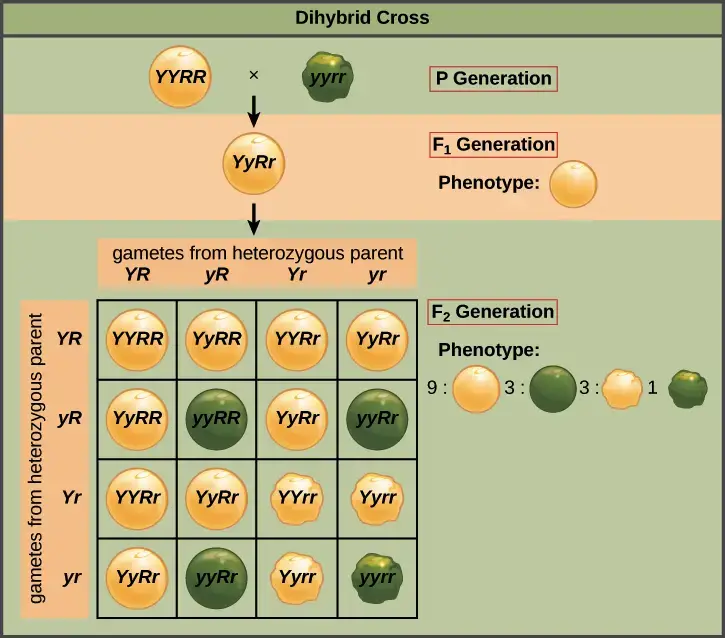
When Does Independent Assortment Occur?
- Independent assortment occurs during the process of meiosis, a specialized form of cell division that plays a pivotal role in sexual reproduction. This process ensures the generation of genetically diverse gamete cells, which are essential for the creation of offspring with unique genetic combinations.
- Meiosis is akin to mitosis in many respects, but its end result differs significantly. While mitosis leads to the creation of genetically identical daughter cells, meiosis gives rise to gamete cells that have half the amount of DNA as regular diploid cells. These gametes are considered haploid. This reduction in DNA content is a crucial step in sexual reproduction, as it enables two gamete cells – one from each parent – to unite and form a diploid zygote, containing all the genetic information required to develop into a new organism.
- The concept of independent assortment is closely linked to another foundational principle of genetics, the Law of Segregation. According to the Law of Segregation, during meiosis, the two different copies of each gene, known as alleles, are separated into different gamete cells. This separation ensures that each gamete carries only one allele for each gene.
- Independent assortment, however, focuses on the random separation of maternal and paternal sources of DNA. Unlike the Law of Segregation, which pertains to the individual alleles of a single gene, the law of independent assortment deals with the distribution of different genes located on different chromosomes. The segregation of chromosomes during meiosis occurs in a manner that is independent of how other chromosomes are segregating.
- In the process of independent assortment, the maternal and paternal chromosomes are divided at random, contributing to the genetic diversity of the resulting gametes. This randomness arises from the way chromosomes align and segregate during the first stage of meiosis. As a result, a gamete might inherit a specific gene’s allele from either the maternal or paternal source in an unpredictable fashion.
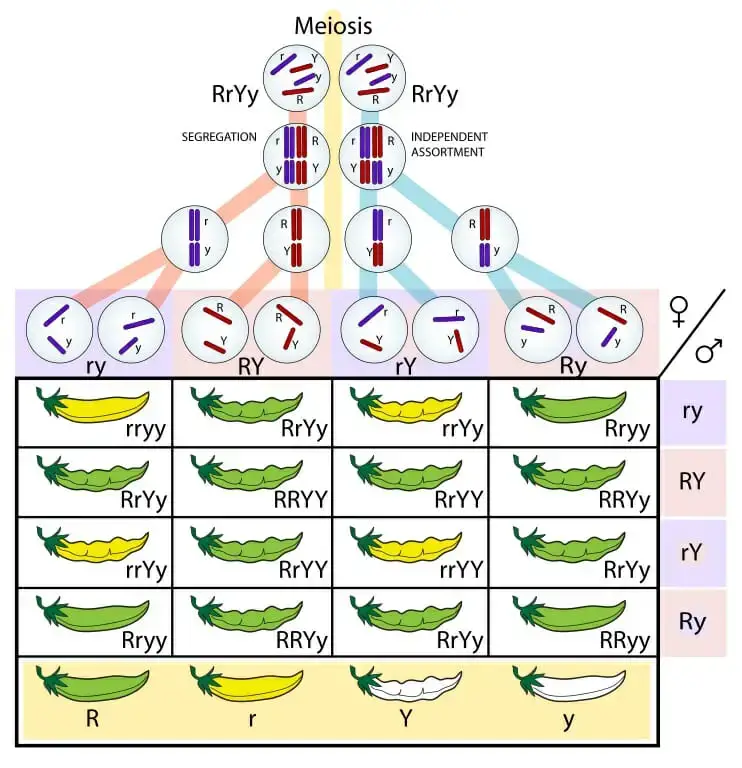
Independent assortment vs. linkage
The comparison between independent assortment and linkage reveals fundamental differences in how genes are inherited and how they can potentially be physically associated on chromosomes. Here’s a breakdown of both concepts and how they contrast:
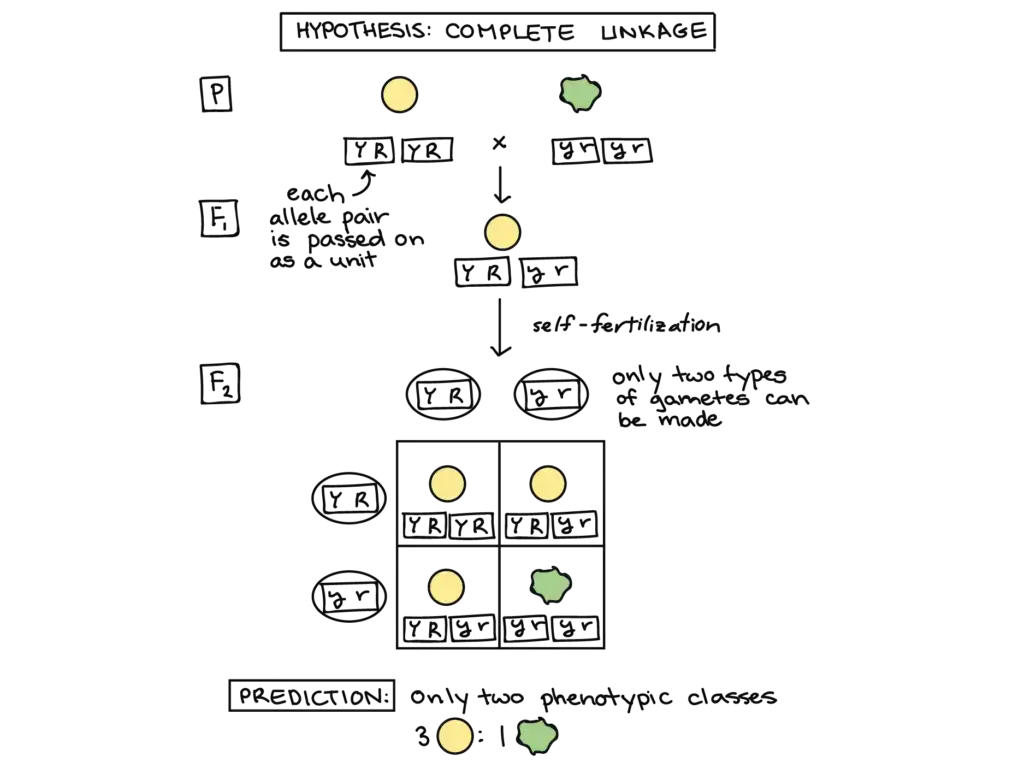
Independent Assortment: Independent assortment is a principle proposed by Mendel that states that alleles of different genes assort or segregate independently during gamete formation. This concept is based on the behavior of different gene pairs on non-homologous chromosomes. During meiosis, homologous chromosomes segregate into different gametes independently of one another, allowing for diverse genetic combinations in offspring.
Linkage: Linkage refers to the tendency of genes located on the same chromosome to be inherited together as a unit, rather than assorting independently. This occurs because these genes are physically close to each other on the same chromosome and are less likely to be separated during crossing-over in meiosis.
The scenario you described involves genes for seed color and seed shape in plants. In the extreme case of complete linkage, these genes could be physically stuck together on the same chromosome. This would result in these genes always being inherited together, and the alleles for seed color and seed shape would not assort independently, as they would be unable to segregate into different gametes during meiosis.
Contrasting the Two Concepts:
- Independent Assortment: If genes assort independently, they segregate into gametes without regard to the behavior of other genes on different chromosomes. This leads to a variety of genetic combinations and can result in a 9:3:3:1 phenotypic ratio in offspring, as observed in Mendel’s classic dihybrid crosses.
- Linkage: If genes are linked, they are inherited together and do not follow the principle of independent assortment. This can lead to a deviation from the expected ratios if the linked genes are considered together.
In the context of your provided content, the illustration and explanation revolve around the hypothetical scenario of complete linkage between genes for seed color and seed shape in plants. However, Mendel’s actual observations and outcomes did not align with the expectations of complete linkage. His experimental results yielded a phenotypic ratio that suggested independent assortment of these traits, providing strong evidence that genes on different chromosomes assort independently during gamete formation.
In conclusion, the concepts of independent assortment and linkage highlight the mechanisms by which genes are inherited and can lead to different phenotypic outcomes. Independent assortment involves the random assortment of alleles on non-homologous chromosomes, while linkage describes the tendency of genes on the same chromosome to be inherited together. Mendel’s pioneering experiments provided empirical evidence for the principle of independent assortment, which has become a cornerstone of modern genetics.
Reason for independent assortment
The phenomenon of independent assortment, which is a cornerstone of genetic diversity, can be traced back to the physical arrangement of genes on chromosomes. This understanding became more refined over time, revealing the reasons behind the occurrence of independent assortment.
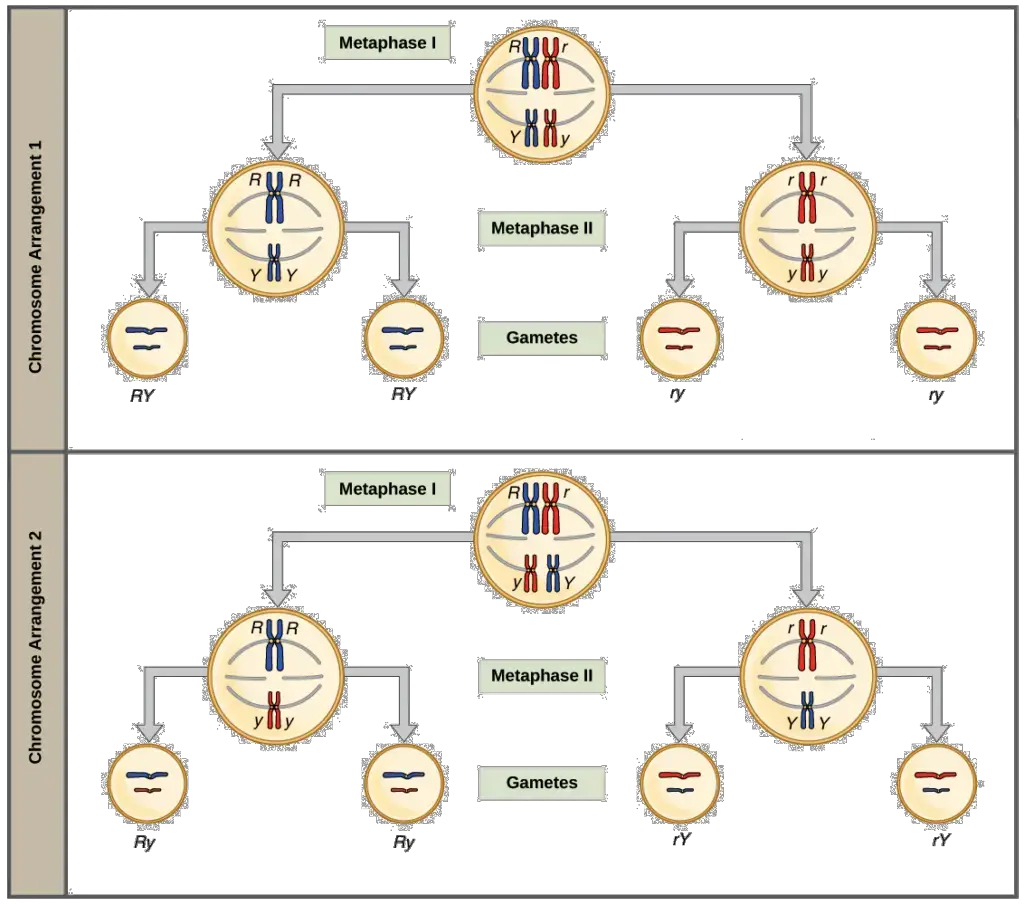
Chromosomal Basis of Genes: Nearly half a century after Mendel’s experiments, the discovery of chromosomes as carriers of genetic information laid the foundation for comprehending the mechanism of independent assortment. Genes, the units of hereditary information, were found to be physically located on chromosomes. Each gene is present in two copies (alleles) on the homologous chromosomes of a pair. These pairs are similar but not identical, with one chromosome inherited from each parent.
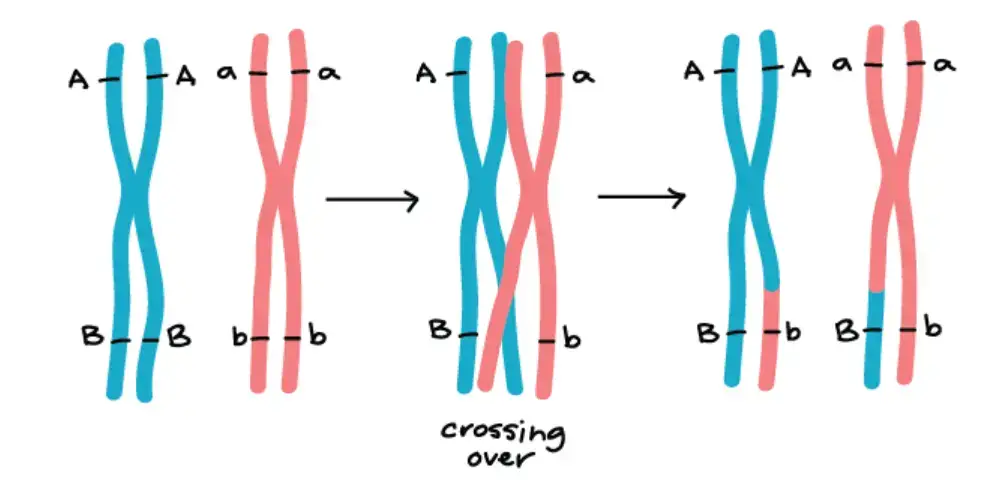
Meiosis and Chromosome Orientation: The physical basis of independent assortment becomes evident during meiosis I, the initial phase of gamete formation. At this stage, homologous chromosome pairs align in a random orientation along the cell’s equatorial plane before they separate. This orientation is crucial, as it determines which alleles will end up in the resulting gametes. Because of this randomness in alignment, different combinations of “mom” and “dad” chromosomes (and their corresponding alleles) are possible.
For instance, in a dihybrid cross involving two genes—say, genes for seed color and seed shape—there are multiple possible alignments of homologous chromosomes. This results in gametes carrying various combinations of alleles from each parent, leading to genetic diversity in the offspring.
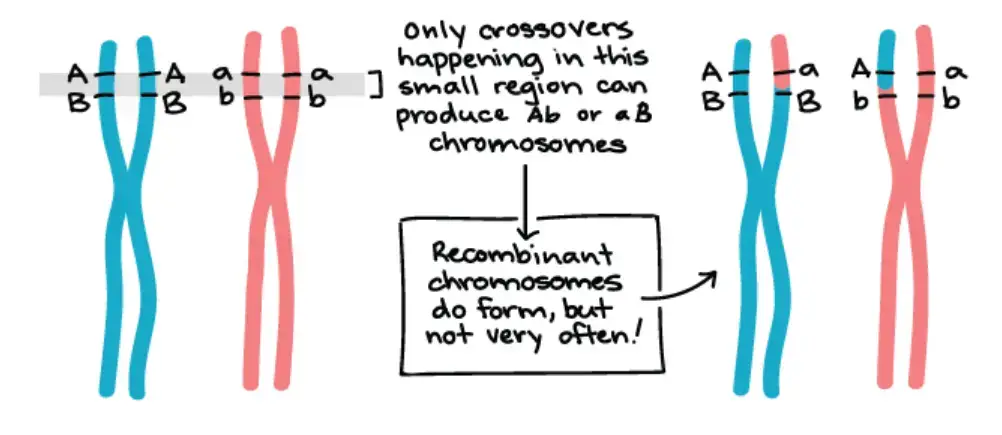
Illustration of Independent Assortment: In a simplified example, imagine homologous chromosome pairs—one set from the mother and another from the father—lining up during metaphase I of meiosis. There are two potential chromosome arrangements: one where the “mom” chromosomes stick together and the “dad” chromosomes do the same, and another where the “mom” and “dad” chromosomes mix. If meiosis occurs repeatedly, as it does in organisms like pea plants, both arrangements will happen with equal frequency. This leads to the formation of different classes of gametes with equal probability.
Exceptions to Independent Assortment: While genes located on different chromosomes and genes that are far apart on the same chromosome can assort independently due to random orientation during meiosis, gene pairs situated closely on the same chromosome may not exhibit independent assortment. Instead, these genes tend to be inherited together as a unit. This phenomenon is known as genetic linkage, and it results from the limited occurrence of crossing over, where homologous chromosome segments exchange during meiosis. Genetic linkage contradicts the principle of independent assortment and is explored in further detail in related articles and discussions.
Limitations of Mendel’s Law of Independent Assortment
- Linked Genes
The Law of Independent Assortment does not apply to genes located on the same chromosome, known as linked genes. Genes that are physically close to each other on the same chromosome tend to be inherited together because they are less likely to be separated by recombination during meiosis. Therefore, the independent assortment of these genes does not occur as predicted by Mendel’s law. - Incomplete Dominance and Codominance
Mendel’s law assumes simple dominance relationships between alleles. However, it does not account for genetic traits exhibiting incomplete dominance or codominance. In incomplete dominance, neither allele is fully dominant, resulting in a blended phenotype. Codominance occurs when both alleles contribute equally and visibly to the phenotype. These interactions can complicate the inheritance patterns predicted by the law. - Polygenic Traits
The Law of Independent Assortment is also limited in the context of polygenic traits, where multiple genes influence a single trait. Traits such as height or skin color are controlled by several genes, and their inheritance does not follow the simple Mendelian principles of independent assortment. Instead, these traits show a more complex pattern of inheritance due to the interaction of multiple alleles.
Mendel’s Law of Independent Assortment Mindmap
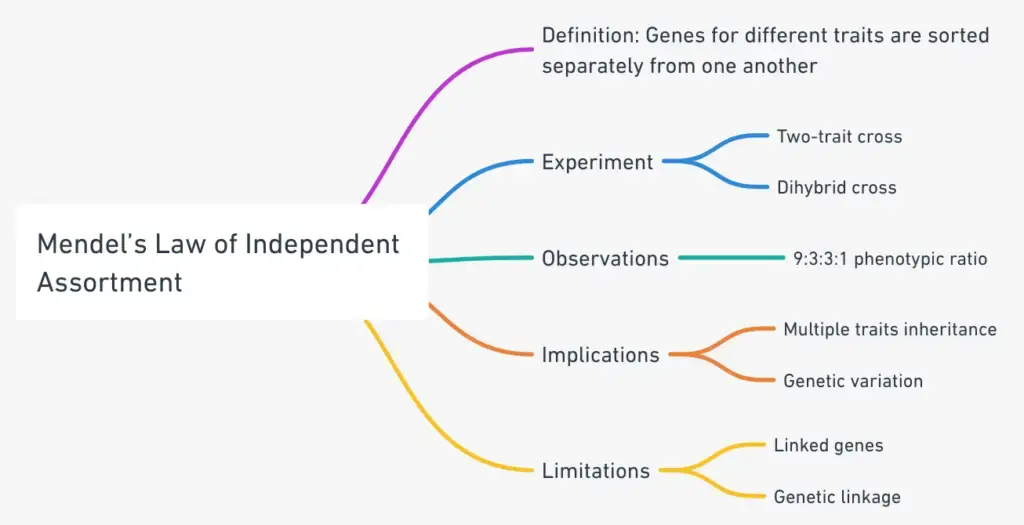
FAQ
What is Mendel’s Law of Independent Assortment?
Mendel’s Law of Independent Assortment states that different genes located on different chromosomes segregate, or assort, into gametes independently of each other during meiosis.
What is the significance of the Law of Independent Assortment?
This law explains how traits controlled by different genes are inherited independently, leading to genetic diversity and the variation observed in offspring.
When does independent assortment occur?
Independent assortment occurs during meiosis, specifically during metaphase I when homologous chromosome pairs align randomly at the cell’s equatorial plane.
What does the term “linked genes” mean in relation to independent assortment?
Linked genes are genes located close together on the same chromosome. Unlike genes on separate chromosomes, linked genes are less likely to assort independently because they tend to be inherited together.
Can genes on the same chromosome ever exhibit independent assortment?
Genes on the same chromosome can exhibit independent assortment if they are far apart from each other. This is due to the occurrence of crossing over, where segments of homologous chromosomes exchange during meiosis.
How does independent assortment lead to genetic diversity?
Independent assortment allows different combinations of alleles from various genes to come together in gametes. When these gametes fuse during fertilization, they create offspring with unique genetic compositions.
What is the relationship between independent assortment and the Law of Segregation?
The Law of Independent Assortment complements the Law of Segregation. While segregation deals with the separation of alleles for a single gene, independent assortment focuses on the random distribution of different gene pairs into gametes.
Does the Law of Independent Assortment apply to genes exhibiting incomplete dominance or codominance?
No, the Law of Independent Assortment does not apply in cases of incomplete dominance or codominance, where both alleles contribute to the phenotype. These situations lead to more complex inheritance patterns.
What does it mean when genes assort independently according to Mendel’s law?
Genes assorting independently means that the inheritance of one gene’s alleles doesn’t affect the inheritance of alleles from another gene. They segregate into gametes in a manner unaffected by other genes.
Are there any exceptions to the Law of Independent Assortment?
Yes, genetic linkage is an exception where genes that are physically close on the same chromosome tend to be inherited together due to a lower likelihood of crossing over. Additionally, interactions between genes or epistasis can affect the expected ratios in some cases.
- Mendel’s Law of Independent Assortment. (2022, June 9). Boundless.
- https://bio.libretexts.org/@go/page/13272
- Biologydictionary.net Editors. (2017, January 20). Law of Independent Assortment. Retrieved from
- https://biologydictionary.net/law-of-independent-assortment/
- https://www.khanacademy.org/science/ap-biology/heredity/mendelian-genetics-ap/a/the-law-of-independent-assortment
- https://unacademy.com/content/neet-ug/study-material/biology/law-of-independent-assortment/
- https://www.biologyonline.com/dictionary/independent-assortment
- https://www.studysmarter.co.uk/explanations/biology/heredity/law-of-independent-assortment/
- https://www.nature.com/scitable/definition/principle-of-independent-assortment-law-of-independent-302/
- Text Highlighting: Select any text in the post content to highlight it
- Text Annotation: Select text and add comments with annotations
- Comment Management: Edit or delete your own comments
- Highlight Management: Remove your own highlights
How to use: Simply select any text in the post content above, and you'll see annotation options. Login here or create an account to get started.